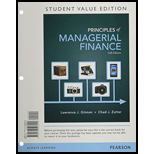
To determine: The compound annual return.
Introduction:
Return is a loss or gain incurred on the investment made by the investors. It is expressed in terms of percentage.
Explanation of Solution
Given information:
T Company initial price of the share is $17 and its price increase to $90 after three years. The company has sold 13.3 million shares in its IPO with a par value of $0.001 per share.
The formula to compute the compound annual return is as follows:
Compute the compound annual return:
Hence, the compound annual return is 74.29%.
To discuss: The method used to value the shares in year 2013.
Explanation of Solution
The method used to value the shares in year 2013 is as follows:
To determine: The paid-in-capital recorded in the
Explanation of Solution
Given information:
T Company initial price of the share is $17 and its price increase to $90 after three years. The company has sold 13.3 million shares in its IPO with a par value of $0.001 per share.
The formula to compute the paid-in-capital is as follow:
Compute the paid-in-capital:
Hence, the paid-in-capital is $0.0133 million.
To discuss: Whether the consumer reports review of the Model S boost T Company’s stock due to raise in cash flows or reduction in the risk.
Explanation of Solution
Determine whether the consumer reports review of the Model S increase T Company’s stock due to raise in cash flows or reduction in the risk:
The Consumer Report review of the Model S can increase T Company’s stock because the review reduces the risk of the company. This Review report minimizes the risk associated with the failure of the products.
Want to see more full solutions like this?
Chapter 7 Solutions
Principles of Managerial Finance, Student Value Edition Plus NEW MyLab Finance with Pearson eText -- Access Card Package (14th Edition)
 Essentials Of InvestmentsFinanceISBN:9781260013924Author:Bodie, Zvi, Kane, Alex, MARCUS, Alan J.Publisher:Mcgraw-hill Education,
Essentials Of InvestmentsFinanceISBN:9781260013924Author:Bodie, Zvi, Kane, Alex, MARCUS, Alan J.Publisher:Mcgraw-hill Education,

 Foundations Of FinanceFinanceISBN:9780134897264Author:KEOWN, Arthur J., Martin, John D., PETTY, J. WilliamPublisher:Pearson,
Foundations Of FinanceFinanceISBN:9780134897264Author:KEOWN, Arthur J., Martin, John D., PETTY, J. WilliamPublisher:Pearson, Fundamentals of Financial Management (MindTap Cou...FinanceISBN:9781337395250Author:Eugene F. Brigham, Joel F. HoustonPublisher:Cengage Learning
Fundamentals of Financial Management (MindTap Cou...FinanceISBN:9781337395250Author:Eugene F. Brigham, Joel F. HoustonPublisher:Cengage Learning Corporate Finance (The Mcgraw-hill/Irwin Series i...FinanceISBN:9780077861759Author:Stephen A. Ross Franco Modigliani Professor of Financial Economics Professor, Randolph W Westerfield Robert R. Dockson Deans Chair in Bus. Admin., Jeffrey Jaffe, Bradford D Jordan ProfessorPublisher:McGraw-Hill Education
Corporate Finance (The Mcgraw-hill/Irwin Series i...FinanceISBN:9780077861759Author:Stephen A. Ross Franco Modigliani Professor of Financial Economics Professor, Randolph W Westerfield Robert R. Dockson Deans Chair in Bus. Admin., Jeffrey Jaffe, Bradford D Jordan ProfessorPublisher:McGraw-Hill Education





